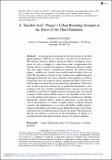Files in this item
A 'suitable soil' : plague's breeding grounds at the dawn of the third pandemic
Item metadata
| dc.contributor.author | Lynteris, Christos | |
| dc.date.accessioned | 2017-12-11T15:30:16Z | |
| dc.date.available | 2017-12-11T15:30:16Z | |
| dc.date.issued | 2017-07 | |
| dc.identifier | 251718917 | |
| dc.identifier | 857d9a95-ff05-4bd7-8b03-aba2813fbed9 | |
| dc.identifier | 85020697640 | |
| dc.identifier.citation | Lynteris , C 2017 , ' A 'suitable soil' : plague's breeding grounds at the dawn of the third pandemic ' , Medical History , vol. 61 , no. 3 , pp. 343-357 . https://doi.org/10.1017/mdh.2017.32 | en |
| dc.identifier.issn | 0025-7273 | |
| dc.identifier.other | ORCID: /0000-0001-8397-0050/work/60630755 | |
| dc.identifier.uri | https://hdl.handle.net/10023/12314 | |
| dc.description | Research leading to this paper was funded by a European Research Council Starting Grant (under the European Union's Seventh Framework Programme/ERC grant agreement no 336564) for the project ‘Visual Representations of the Third Plague Pandemic’ at CRASSH, University of Cambridge. | en |
| dc.description.abstract | A pressing question during the first half-decade of the third plague pandemic (1894–9) was what was a ‘suitable soil’ for the disease. The question related to plague’s perceived ability to disappear from a given city only to reappear at some future point; a phenomenon that became central to scientific investigations of the disease. However, rather than this simply having a metaphorical meaning, the debate around plague’s ‘suitable soil’ actually concerned the material reality of the soil itself. The prevalence of plague in the working-class neighbourhood of Taipingshan during the first major outbreak of the pandemic, in 1894 in Hong Kong, led to an extensive debate regarding the ability of the soil to harbour and even spread the disease. Involving experiments, which were seen as able to procure evidence for or against the demolition or even torching of the area, scientific and administrative concerns over the soil rendered it an unstable yet highly productive epistemic thing. The spread of plague to India further fuelled concerns over the ability of the soil to act as the medium of the disease’s so-called true recrudescence. Besides high-profile scientific debates, hands-on experiments on purifying the soil of infected houses by means of highly intrusive methods allowed scientists and administrators to act upon and further solidify plague’s supposed invisibility in the urban terrain. Rather than being a short-lived, moribund object of epidemiological concern, this paper will demonstrate that the soil played a crucial role in the development of plague as a scientifically knowable and actionable category for modern medicine. | |
| dc.format.extent | 18 | |
| dc.format.extent | 197331 | |
| dc.language.iso | eng | |
| dc.relation.ispartof | Medical History | en |
| dc.subject | Plague | en |
| dc.subject | Hong Kong | en |
| dc.subject | India | en |
| dc.subject | Soil | en |
| dc.subject | Experiments | en |
| dc.subject | Colonial medicine | en |
| dc.subject | GN Anthropology | en |
| dc.subject | D204 Modern History | en |
| dc.subject | RA0421 Public health. Hygiene. Preventive Medicine | en |
| dc.subject | T-NDAS | en |
| dc.subject | SDG 3 - Good Health and Well-being | en |
| dc.subject.lcc | GN | en |
| dc.subject.lcc | D204 | en |
| dc.subject.lcc | RA0421 | en |
| dc.title | A 'suitable soil' : plague's breeding grounds at the dawn of the third pandemic | en |
| dc.type | Journal article | en |
| dc.contributor.sponsor | European Research Council | en |
| dc.contributor.institution | University of St Andrews. Social Anthropology | en |
| dc.identifier.doi | 10.1017/mdh.2017.32 | |
| dc.description.status | Peer reviewed | en |
| dc.identifier.grantnumber | 336564 | en |
This item appears in the following Collection(s)
Items in the St Andrews Research Repository are protected by copyright, with all rights reserved, unless otherwise indicated.

